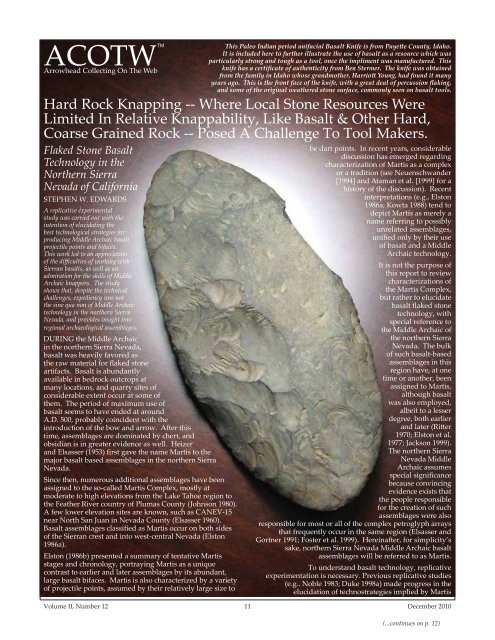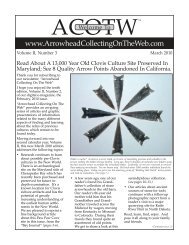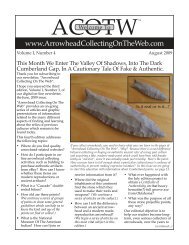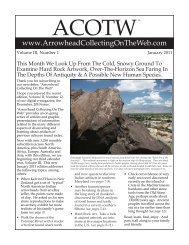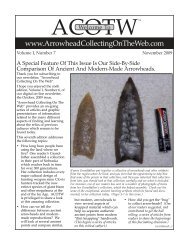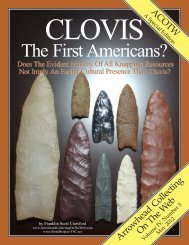Rock, Paper, Scissors - Arrowhead Collecting On The Web
Rock, Paper, Scissors - Arrowhead Collecting On The Web
Rock, Paper, Scissors - Arrowhead Collecting On The Web
You also want an ePaper? Increase the reach of your titles
YUMPU automatically turns print PDFs into web optimized ePapers that Google loves.
ACOTW<br />
<strong>Arrowhead</strong> <strong>Collecting</strong> <strong>On</strong> <strong>The</strong> <strong>Web</strong><br />
<strong>Arrowhead</strong> <strong>Collecting</strong> <strong>On</strong> <strong>The</strong> <strong>Web</strong><br />
TM This Paleo Indian period unifacial Basalt Knife is from Payett e County, Idaho.<br />
Hard <strong>Rock</strong> Knapping -- Where Local Stone Resources Were<br />
Limited In Relative Knappability, Like Basalt & Other Hard,<br />
Coarse Grained <strong>Rock</strong> -- Posed A Challenge To Tool Makers.<br />
Flaked Stone Basalt<br />
Technology in the<br />
Northern Sierra<br />
Nevada of California<br />
STEPHEN W. EDWARDS<br />
A replicative experimental<br />
study was carried out with the<br />
intention of elucidating the<br />
best technological strategies for<br />
producing Middle Archaic basalt<br />
projectile points and bifaces.<br />
This work led to an appreciation<br />
of the diffi culties of working with<br />
Sierran basalts, as well as an<br />
admiration for the skills of Middle<br />
Archaic knappers. <strong>The</strong> study<br />
shows that, despite the technical<br />
challenges, expediency was not<br />
the sine qua non of Middle Archaic<br />
technology in the northern Sierra<br />
Nevada, and provides insight into<br />
regional archaeological assemblages.<br />
DURING the Middle Archaic<br />
in the northern Sierra Nevada,<br />
basalt was heavily favored as<br />
the raw material for fl aked stone<br />
artifacts. Basalt is abundantly<br />
available in bedrock outcrops at<br />
many locations, and quarry sites of<br />
considerable extent occur at some of<br />
them. <strong>The</strong> period of maximum use of<br />
basalt seems to have ended at around<br />
A.D. 500, probably coincident with the<br />
introduction of the bow and arrow. After this<br />
time, assemblages are dominated by chert, and<br />
obsidian is in greater evidence as well. Heizer<br />
and Elsasser (1953) fi rst gave the name Martis to the<br />
major basalt based assemblages in the northern Sierra<br />
Nevada.<br />
Since then, numerous additional assemblages have been<br />
assigned to the so-called Martis Complex, mostly at<br />
moderate to high elevations from the Lake Tahoe region to<br />
the Feather River country of Plumas County (Johnson 1980).<br />
A few lower elevation sites are known, such as CANEV-15<br />
near North San Juan in Nevada County (Elsasser 1960).<br />
Basalt assemblages classifi ed as Martis occur on both sides<br />
of the Sierran crest and into west-central Nevada (Elston<br />
1986a).<br />
Elston (1986b) presented a summary of tentative Martis<br />
stages and chronology, portraying Martis as a unique<br />
contrast to earlier and later assemblages by its abundant,<br />
large basalt bifaces. Martis is also characterized by a variety<br />
of projectile points, assumed by their relatively large size to<br />
It is included here to further illustrate the use of basalt as a resource which was<br />
particularly strong and tough as a tool, once the impliment was manufactured. This<br />
knife has a certifi cate of authenticity from Ben Stermer. <strong>The</strong> knife was obtained<br />
from the family in Idaho whose grandmother, Harriott Young, had found it many<br />
years ago. This is the front face of the knife, with a great deal of percussion fl aking,<br />
and some of the original weathered stone surface, commonly seen on basalt tools.<br />
be dart points. In recent years, considerable<br />
discussion has emerged regarding<br />
characterization of Martis as a complex<br />
or a tradition (see Neuenschwander<br />
[1994] and Ataman et al. [1999] for a<br />
history of the discussion). Recent<br />
interpretations (e.g., Elston<br />
1986a; Kowta 1988) tend to<br />
depict Martis as merely a<br />
name referring to possibly<br />
unrelated assemblages,<br />
unifi ed only by their use<br />
of basalt and a Middle<br />
Archaic technology.<br />
It is not the purpose of<br />
this report to review<br />
characterizations of<br />
the Martis Complex,<br />
but rather to elucidate<br />
basalt fl aked stone<br />
technology, with<br />
special reference to<br />
the Middle Archaic of<br />
the northern Sierra<br />
Nevada. <strong>The</strong> bulk<br />
of such basalt-based<br />
assemblages in this<br />
region have, at one<br />
time or another, been<br />
assigned to Martis,<br />
although basalt<br />
was also employed,<br />
albeit to a lesser<br />
degree, both earlier<br />
and later (Ritt er<br />
1970; Elston et al.<br />
1977; Jackson 1999).<br />
<strong>The</strong> northern Sierra<br />
Nevada Middle<br />
Archaic assumes<br />
special signifi cance<br />
because convincing<br />
evidence exists that<br />
the people responsible<br />
for the creation of such<br />
assemblages were also<br />
responsible for most or all of the complex petroglyph arrays<br />
that frequently occur in the same region (Elsasser and<br />
Gortner 1991; Foster et al. 1999). Hereinafter, for simplicity’s<br />
sake, northern Sierra Nevada Middle Archaic basalt<br />
assemblages will be referred to as Martis.<br />
To understand basalt technology, replicative<br />
experimentation is necessary. Previous replicative studies<br />
(e.g.. Noble 1983; Duke 1998a) made progress in the<br />
elucidation of technostrategies implied by Martis<br />
Volume II, Number 12 11<br />
December 2010<br />
(...continues on p. 12)


